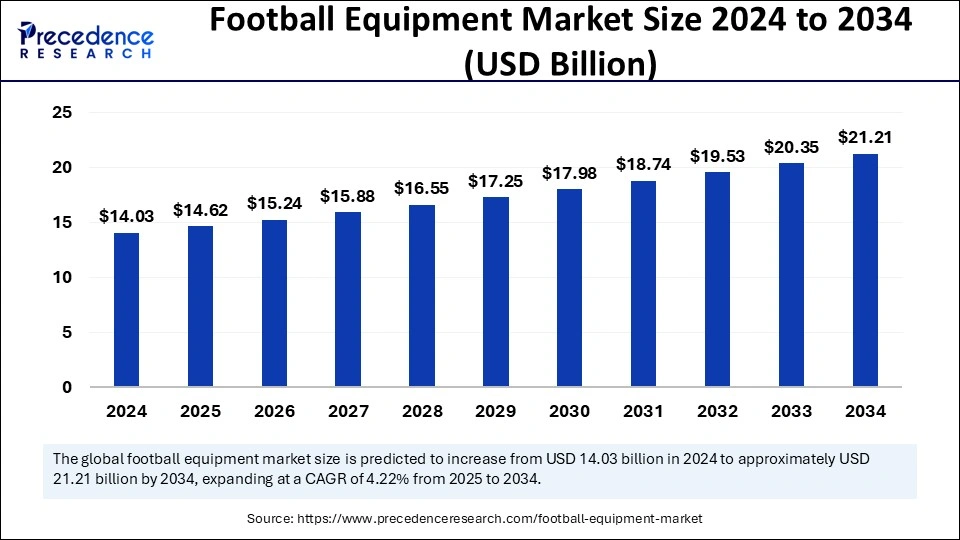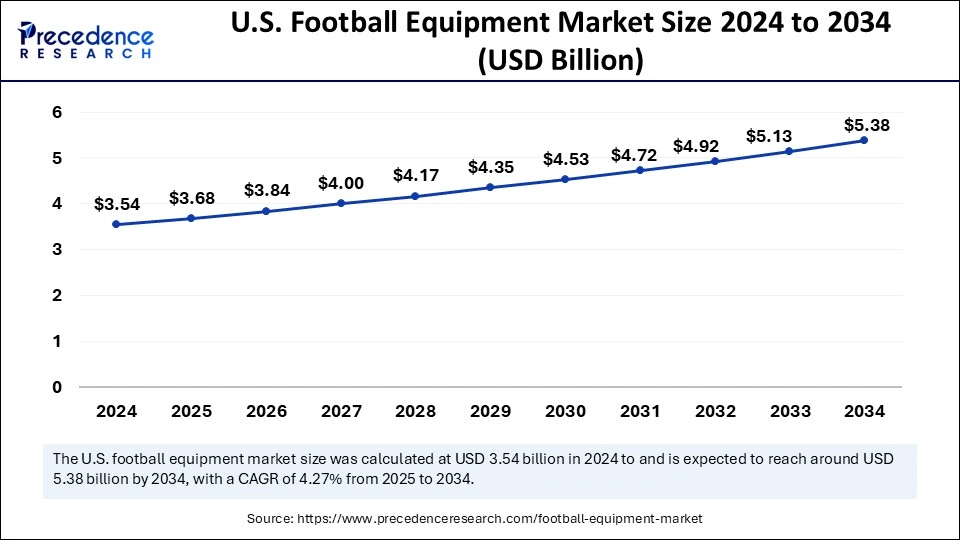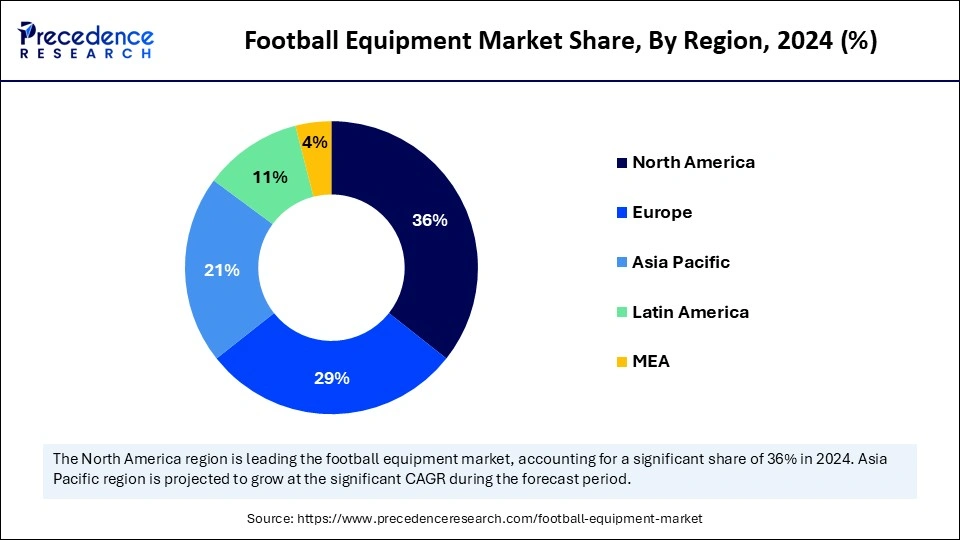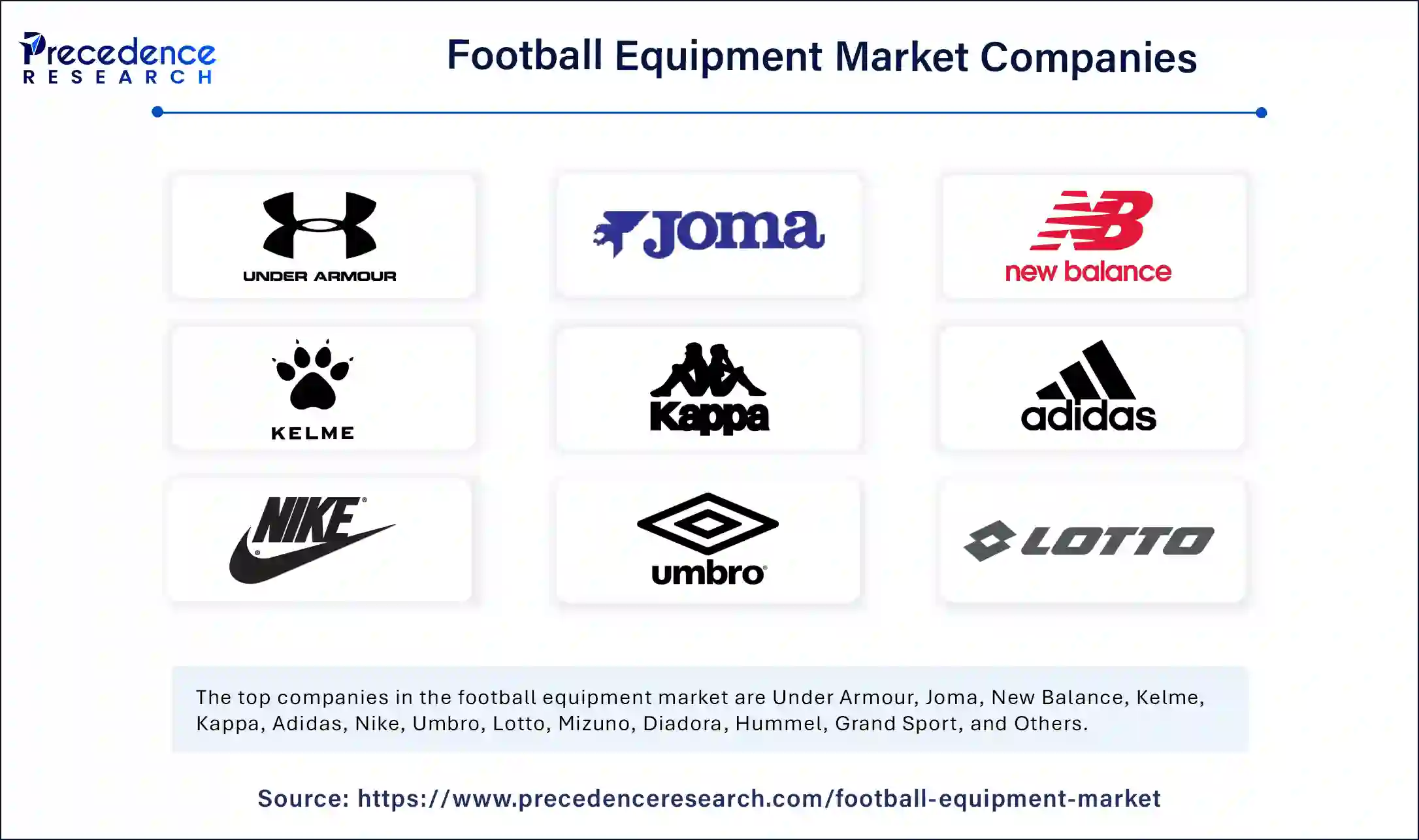October 2024
The global football equipment market size is calculated at USD 14.62 billion in 2025 and is forecasted to reach around USD 21.21 billion by 2034, accelerating at a CAGR of 4.22% from 2025 to 2034. The North America market size surpassed USD 5.05 billion in 2024 and is expanding at a CAGR of 4.23% during the forecast period. The market sizing and forecasts are revenue-based (USD Million/Billion), with 2024 as the base year.
The global football equipment market size was estimated at USD 14.03 billion in 2024 and is predicted to increase from USD 14.62 billion in 2025 to approximately USD 21.21 billion by 2034, expanding at a CAGR of 4.22% from 2025 to 2034. The growth of the football equipment market is driven by the growing popularity of football as a sport in various regions, heightened safety awareness, and technological advancements that have improved the performance and comfort of football gear. Moreover, the demand for football equipment is rising as educational institutions like schools, colleges, and sports academies are focusing on sports education and physical fitness.

Artificial intelligence is reshaping the football equipment industry by enhancing performance assessments, streamlining training processes, and boosting product development. AI-equipped smart footballs that have embedded sensors offer immediate data regarding ball trajectory, spin, and speed, enabling players and coaches to refine their techniques. Wearable devices powered by AI, such as Global Positioning System (GPS) vests and smart insoles, monitor player movements, fatigue levels, and injury risks, facilitating customized training plans. Additionally, AI transforms football boots with tailor-made 3D-printed cleats that improve comfort based on biomechanical data.
AI-driven video analysis tools assist teams in evaluating gameplay strategies, player positioning, and opponent weaknesses. In retail, AI improves consumer experience through virtual fittings, personalized gear suggestions, and automated stock management. AI-enhanced smart stadiums utilize predictive analytics to optimize pitch conditions, boost fan engagement, and reinforce safety measures. Moreover, AI is used in referee assistance technologies, supporting precise decision-making with immediate offside detection and foul assessment. Incorporating AI-generated insights in youth training academies broadens access to the sport. As AI continues to evolve, its application in football equipment will promote performance enhancement, injury prevention, and smarter game tactics, influencing future innovation in football.
The U.S. football equipment market size was exhibited at USD 3.54 billion in 2024 and is projected to be worth around USD 5.38 billion by 2034, growing at a CAGR of 4.27% from 2025 to 2034.

North American Football Equipment Market Trends
North America dominated the market with the largest share in 2024. This is mainly due to the increased consumer spending on sports, a strong sports culture, and the presence of prominent brands. The region sees considerable investment in professional and grassroots football, stimulating demand for premium footballs, cleats, and protective gear. Major League Soccer (MLS)'s growing prominence and increased youth participation have also driven market expansion. Moreover, advancements in AI-driven sports analytics and smart training equipment are gaining popularity as players and clubs incorporate technology into their training regimens. The expansion of online retail platforms and direct-to-consumer brand strategies also play a role in increasing sales.
United States
The U.S. commands the largest portion of the football equipment market in North America, spurred by the swift expansion of MLS, collegiate football programs, and youth academies. The boost in viewership and participation rates, magnified by international football tournaments and star player acquisitions in American leagues, has considerably increased demand for high-end football gear. Major sporting goods companies are partnering with professional teams and universities to offer tailored equipment. In addition, the growth of smart training technologies, including AI-powered coaching tools and wearable devices, is improving player performance and affecting equipment sales. The growth of online retail platforms is further propelling market progression.
Canada
Canada represents another significant market in North America, experiencing a rise in football participation driven by the growth of youth academies, increased government investment, and the development of professional leagues. The achievements of Canadian national teams in international competitions have heightened interest in football, leading to greater demand for high-quality equipment. Additionally, the preference for eco-friendly football gear and sustainable materials is rising among Canadian consumers. Major sporting goods stores are broadening their reach both offline and online, offering a wide array of football gear, from professional-level products to beginner equipment. The ongoing focus on grassroots development continues to foster market growth.

European Football Equipment Market Trends
Europe is projected to witness rapid growth in the coming years due to the rising popularity of professional football leagues, well-established training academies, and substantial consumer expenditure on sports gear. Football is a significant part of European culture, resulting in a steady demand for high-quality equipment, bespoke cleats, and cutting-edge training gear. The emergence of sustainable and eco-friendly football products and the growth of digital retail are also contributing to market expansion. Additionally, the application of AI-driven performance analytics, smart footwear, and wearable technology is transforming training methods for players, driving the need for technologically advanced football gear.
United Kingdom
The United Kingdom stands out as a vital market in Europe, hosting some of the globe's most renowned football clubs and leagues, including the English Premier League (EPL). Football superstars' influence and global fans' engagement significantly boost the demand for football gear. Consumers in the UK prefer premium-quality footballs, high-performance cleats, and club-branded merchandise, promoting market growth. The introduction of AI-driven training tools and virtual coaching platforms is also shaping purchasing patterns. Moreover, the increasing trend toward sustainable sports equipment is encouraging brands to create eco-friendly football gear that aligns with changing consumer preferences.
Germany
Germany is another prominent marketplace within Europe. The Bundesliga, leading football academies, and grassroots football initiatives drive the regional market growth. Football sport is highly popular in Germany, with significant participation across various age groups. The need for high-performance boots, protective gear, and smart training devices is rising as technology becomes more integral to football training. In addition, German brands like Adidas maintain a stronghold in the market by exploiting their extensive presence in both offline and online retail channels. Sustainability is increasingly important, with biodegradable footballs and shoes made from recycled materials gaining traction among environmentally conscious consumers.
Asia Pacific Football Equipment Market Trends
Asia Pacific is considered to be a significantly growing area during the forecast period. The region's increasing enthusiasm for football, propelled by rising youth participation, government-supported sports programs, and the growth of domestic leagues, is driving the demand for football gear. Nations such as China, India, and Japan are seeing increased investments in football academies, sports infrastructure, and professional leagues, amplifying the necessity for high-quality equipment. The rising influence of international football clubs, sponsorship agreements, and digital marketing initiatives further boost market growth. Additionally, the e-commerce surge is enhancing accessibility to premium football gear.
China
China is progressively establishing itself as a key player in the football equipment market due to extensive investments in sports development, government-supported initiatives, and a proliferation of football academies. The Chinese Super League (CSL) has gained worldwide recognition, attracting professional and amateur interest in football. Leading brands are aggressively growing in China, utilizing celebrity endorsements and digital marketing techniques. Demand for smart footballs, AI-based wearables, and sustainable sports equipment is increasing as consumers seek both technologically advanced and eco-friendly options. Furthermore, the growth of online sports retail platforms is enhancing the availability of high-quality gear to consumers.
India
Football participation in India is on the rise, spurred by the Indian Super League (ISL), grassroots football initiatives, and international partnerships. Enhanced government programs promoting sports in schools have increased the demand for football equipment. Global brands are focusing on the Indian market by offering affordable football gear, launching digital marketing campaigns, and collaborating with local leagues. The rise of online retail platforms also improves accessibility to football equipment, especially in tier-2 and tier-3 cities. Furthermore, there is a growing need for cost-effective yet durable football gear, positioning India as one of the fastest-expanding markets for football equipment.
The football equipment market encompasses a diverse range of items, including protective gear, footwear, training tools, and apparel, that are crucial for ensuring players' safety and performance. Characterized by its essential nature, these products guarantee player safety, boost performance, and are relevant in environments from amateur recreation to professional leagues. The market is witnessing rapid growth due to the growing global enthusiasm for football, heightened awareness of safety regulations, and technological progress in materials that offer improved performance and durability. There is potential for growth in the use of eco-friendly and sustainable materials for equipment production, appealing to environmentally conscious consumers and aligning with worldwide sustainability trends.
A significant factor contributing to the growth of the football equipment market is the increasing global passion for the sport. Football's appeal extends beyond professional leagues and international competitions; it has also penetrated grassroots levels. With initiatives by FIFA and regional organizations to promote football in developing regions, there has been a marked rise in participant numbers, especially among youth and amateur players. This expanding player base creates a demand for high-quality equipment, driving market growth. Additionally, the rise in local and international tournaments has heightened the need for high-performance gear as players look for equipment that ensures optimal safety and improves their performance on the field.
| Report Coverage | Details |
| Market Size by 2034 | USD 21.21 Billion |
| Market Size in 2025 | USD 14.62 Billion |
| Market Size in 2024 | USD 14.03 Billion |
| Market Growth Rate from 2025 to 2034 | CAGR of 4.22% |
| Dominating Region | North America |
| Fastest Growing Region | Asia Pacific |
| Base Year | 2024 |
| Forecast Period | 2025 to 2034 |
| Segments Covered | Product Type, Material, Distribution Channel, End-User, and Regions |
| Regions Covered | North America, Europe, Asia-Pacific, Latin America, and Middle East & Africa |
Rising Popularity of Football
The expanding popularity of football among various age groups and skill levels is a significant factor driving the growth of the football equipment market. The expansion of professional leagues, college football, and grassroots programs globally is boosting the demand for football equipment, including cleats, protective gear, and training accessories. Leading brands are investing in team and athlete sponsorships to improve brand visibility, further enhancing sales. Moreover, the rising participation of women in sports and the increasing popularity of women’s football drive market growth. The rising investments in youth training programs further support market growth, establishing football equipment as a continually expanding segment in the sports sector.
High Costs of Advanced Football Gear
A major hurdle in the football equipment market is the elevated cost of premium and technologically advanced gear. High-quality protective equipment, smart wearables, and top-tier football boots often come with hefty price tags, limiting accessibility for amateur players and youth participants. Additionally, the rapid pace of technological improvements leads to frequent product obsolescence, requiring players and teams to frequently acquire the latest models. This financial barrier restricts market entry, especially in developing regions where affordability is a critical issue despite the increasing allure of football.
Growing Demand for Smart and Eco-Friendly Football Equipment
Innovations such as smart footballs, GPS-enabled vests, and injury-prevention devices enhance players’ safety. Moreover, the increasing consumer inclination toward eco-friendly and sustainable football equipment is prompting manufacturers to implement recycled materials and biodegradable components. Leading brands are releasing sustainable football boots, environmentally friendly jerseys, and biodegradable shin guards to appeal to eco-conscious players. This trend aligns with the global sustainability movement, allowing businesses to broaden their customer base and distinguish their products in the competitive football equipment landscape.
The football segment dominated the football equipment market with the largest share in 2024. As the essential element of the game, football demand has increased across professional leagues, amateur competitions, and recreational use. The global rise in football's popularity and subsequent investments in professional leagues and grassroots programs have significantly enhanced sales. Furthermore, innovations in ball technology led to the development of smart footballs and connected ball technology with integrated sensors for performance metrics tracking, which have gained popularity. Top brands are persistently enhancing footballs' quality, durability, and aerodynamics, reinforcing this segment's market dominance.
The footwear segment is expected to grow at the fastest rate during the forecast period. Cleats, also known as football boots, are crucial for enhancing players' performance. The rising emphasis on innovations in materials and design to improve comfort drives segmental growth. Top brands are utilizing lightweight materials, AI-assisted design strategies, and smart insoles to improve player agility and minimize injuries. The trend toward custom-made and eco-friendly cleats is also rising, influenced by sustainability movements. Furthermore, endorsements from professional athletes are greatly impacting purchase choices, supporting the segment's growth.
The leather segment led the football equipment market in 2024. Leather has been favored for high-end footballs and premium boots due to its durability, flexibility, and exceptional feel. Elite players and professional teams often opt for leather-based footballs and cleats to enhance ball control and performance. Nevertheless, in light of growing sustainability concerns, companies are creating eco-friendly leather substitutes while upholding high-quality standards. Even with the increasing popularity of synthetic materials, leather continues to be the preferred option, especially among traditional and premium buyers who prioritize performance over price.
The synthetic segment is likely to witness notable growth during the projection period. Innovations in synthetic materials have resulted in lighter, more durable, and water-resistant football equipment, making them increasingly popular among players. Synthetic materials provide affordability and high customization possibilities, prompting brands to invest in innovative, AI-engineered materials to enhance durability and performance. The rising demand for recycled synthetic options is further driving the growth of this segment as sustainability becomes a central focus within the sports sector.
The offline retail segment dominated the football equipment market in 2024. Conventional sports retailers, specialized football shops, and large sporting goods chains remain significant sales channels for football equipment. Many consumers prefer in-person stores to try on footwear, evaluate ball grip, and receive expert recommendations prior to making a purchase. The availability of exclusive brand shops, official club outlets, and promotional activities in sports retailers further enhances offline sales. Additionally, collaborations between manufacturers and retail outlets for personalized fittings and product launches continue reinforcing this segment's position.
The online retail segment is anticipated to expand at the fastest rate over the studied period. The swift digitization of retail and the rising preference for e-commerce platforms have revolutionized the football equipment industry. Consumers now have access to a diverse range of products, competitive pricing, and exclusive online-only promotions. The advent of AI-guided size recommendations and virtual fitting technology is further enhancing the online shopping experience. Moreover, major brands are broadening their direct-to-consumer (DTC) approaches, offering tailored football gear and exclusive online collections to attract digital shoppers.
The professional players segment dominated the market with a major share in 2024. Professional football athletes necessitate top-quality, performance-boosting equipment, which drives the demand for premium footballs, cleats, protective gear, and training accessories. Leading brands partner with elite clubs and national teams to provide customized equipment designed to meet the specific needs of top athletes. Additionally, technological advancements in professional gear, such as smart wearables, GPS tracking vests, and AI-assisted performance analysis, have further propelled growth in this segment. The increasing commercialization of football, lucrative sponsorship deals, and ongoing innovations are crucial factors supporting this segment's growth.
The youth players segment is projected to grow at a considerable rate during the projection period. The surge in football’s appeal among children and teenagers has increased the need for football gear. Companies are launching cost-effective, lightweight, and age-specific football equipment to meet the demands of a broader consumer base. Furthermore, the impact of social media, popular football figures, and the rise in female participation in the sport motivate more young people to participate in football. The emergence of smart training tools aimed at enhancing the performance of young players is also rising.

By Product Type
By Material
By Distribution Channel
By End-user
By Region
For inquiries regarding discounts, bulk purchases, or customization requests, please contact us at sales@precedenceresearch.com
No cookie-cutter, only authentic analysis – take the 1st step to become a Precedence Research client
October 2024
March 2025